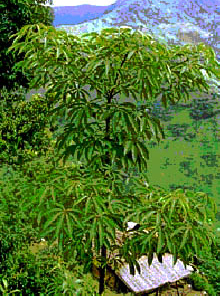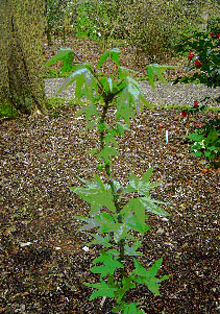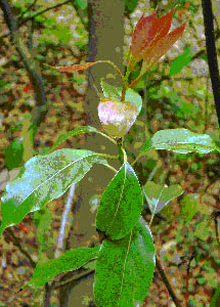Trees that impress
by
Gary Long
Gary has worked in Cornish gardens for 20 years, starting at the National Trust garden, Trelissick, before spending four years at St. Michaels Hotel and Falmouth Beach Resort Hotel, both in Falmouth. He won numerous Falmouth in Bloom prizes for the gardens and hanging baskets. After that he spent nine years at Tregothnan Botanic gardens in the role of assistant head gardener, achieving a Chelsea Gold medal and studying to RHS diploma level. In January 2004 he took over as head gardener at Trewithen gardens.
The trend of using foliage-effect plants with "On the edge" hardiness has become increasingly popular in recent times. Is it because of climate change? Or are we just a bit braver than our gardening predecessors? With the seasons blending into one another, i.e. summer slowly drifting into winter, and a lack of autumn, the conditions for such plants have never been better. In Cornwall, at least, the winters are long and mild with the growing season longer than ever. Plants which traditionally we see as tender are now being used in gardens all over the county, not just on Tresco.
Nurseries are pushing the boundaries of what is available by sourcing and supplying "tender, exotic, tropical" plants which are increasingly available at nurseries like Hardy Exotics, Trevena Cross, and the Duchy of Cornwall Nursery etc. The list of plants available to the Cornish gardeners is ever increasing and all the more exciting.
Here are some of the plants that you should try in your garden.
Araliaceae: Schefflera impressa
The name sums this tree up: 'impressive.' The genus is found in warm temperate regions of South East Asia, the Pacific islands and Central and South America. S. impressa comes from the Himalayas and is one of the hardiest species. Some of the species are more commonly seen as house plants. This is a spreading, stoutly branched tree with leaves made up of stalked leaflets, radiating from a long petiole from 20 to 50 cms, and fully divided. The leaves have a pale brown covering which fades to green throughout the season. Others include S. elegantissima, S. heptaphylla.
Araliaceae: Kalopanax septemlobus
This is a wonderful, spreading, deciduous tree with spikes on the trunk and branches (careful how you handle this one!). It has variably shaped, lobed, dark green leaves. It is also in the Araliaceae family, so expect "Fatsia" type leaves. In late summer, umbel-like panicles of small white flowers are followed by blue/black fruits. It hails from East Asia and is hardy, but young leaves may be damaged by late frosts. A specimen with true all-year-round interest. A stunner!
Araliaceae: Tetrapanax papifera
Yet another from the Araliaceae family. A gorgeous thicket-forming evergreen shrub or small tree. Leaves are palmate, lobed and scaly with a felted pale green underside and mid green above. In autumn it produces umbels of white flowers, particularly loved by bees and followed by small, 3mm fruit. It comes from South China and Taiwan. It is hardy, but top growth can be burnt by frost with the plant re-growing from below ground. It needs full sun and shelter from cold winds. Well worth a try!
Euphorbiaceae: Euphorbia mellifera
Euphorbia mellifera has to be one of the most under-used shrubs available to gardeners. It is part of a large genus distributed across a range of habitats in temperate, tropical and subtropical regions. Its lush, oblong, lanceolate leaves on stout branches form a neat, rounded evergreen shrub. Late spring sees honey scented flowers form en-masse, smothering the whole bush. These are followed by pea-like, warty fruit in late summer. This is a well behaved, neat and tidy shrub for a sunny spot. A must-have plant.
Lauraceae: Cinnamonum Camphora
Camphor Laurel is another under-used plant. It comes from a genus of about 250 species, all evergreen and from forests in East- and South-East Asia and Australia. The leathery, aromatic, glossy leaves are its most important feature, tinted red when young. The flowers are rather insignificant, consisting of greenish yellow clusters from late spring to summer, followed by black berries. It does best in moist well drained soil, in sun or partial shade. An excellent foliage plant.
Atherospermataceae: Laurelia sempervirens
The genus consists of three species, all evergreen trees and shrubs from the forests and stream banks of New Zealand, Chile and Argentina. It is usually grown for its aromatic foliage. It forms a conical tree with elliptic leaves, toothed at the margin, and bright green. An ideal woodland plant. It is an experience to sit beneath it on a warm still day, the air filled with an aroma similar to freshly baked ginger bread - it's enough to make you feel hungry!
© 2005 Gary Long
 Schefflera impressa
Schefflera impressa
 Kalopanax septemlobus
Kalopanax septemlobus
 Tetrapanax papifera
Tetrapanax papifera
 Euphorbia mellifera
Euphorbia mellifera
 Cinnamonum camphora
Cinnamonum camphora
